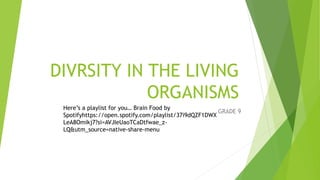
PPT FULL DIVERSITY IN THE LIVING ORGANISMS.pptx
- 1. DIVRSITY IN THE LIVING ORGANISMS GRADE 9 Here’s a playlist for you… Brain Food by Spotifyhttps://open.spotify.com/playlist/37i9dQZF1DWX LeA8Omikj7?si=AVJIeUaoTCaDtfwae_z- LQ&utm_source=native-share-menu
- 8. Whittaker’s System of Classification It is the five kingdom classification. In the 20th century, advances in cell biology and interest in evolutionary biology led scientists to question the two or three-kingdom classification schemes. In 1969, Robert H. Whittaker proposed a system which recognizes five kingdoms of living things: Monera (Bacteria), Protista, Fungi, Plantae and Animalia
- 24. Basis for Animal Kingdom Classification Classification of Animal Kingdom is based on various fundamental features like – 1.Levels of Organisation, 2.Symmetry, 3.Diploblastic and Triploblastic Organisation, 4.Coelom development, 5.Segmentation of the body and 6.Presense or absence of Notochord. •The broad classification of Animalia based on common fundamental features:
- 25. Levels of Organisation •Though all members of Animalia are multicellular, all of them do not exhibit the same pattern of organisation of cells. •For example, in sponges, the cells are arranged as loose cell aggregates, i.e., they exhibit cellular level of organisation. Some division of labour (activities) occur among the cells. •In coelenterates, the arrangement of cells is more complex. Here the cells performing the same function are arranged into tissues, hence is called tissue level of organisation. •A still higher level of organisation, i.e., organ level [organ level of organisation] is exhibited by members of Platyhelminthes and other higher phyla where tissues are grouped together to form organs, each specialised for a particular function. •In animals like Annelids, Arthropods, Molluscs, Echinoderms and Chordates, organs have associated to form functional systems, each system concerned with a specific physiological function. This pattern is called organ system level of organisation. •Organ systems in different groups of animals exhibit various patterns of complexities. •For example, the digestive system in Platyhelminthes (incomplete digestive system) has only a single opening to the outside of the body that serves as both mouth and anus, and is hence called incomplete. A complete digestive system has two openings, mouth and anus. •Similarly, the circulatory system may be of two types: open type in which the blood is pumped out of the heart and the cells and tissues are directly bathed in it and closed type in which the blood is circulated through a series of vessels of varying diameters (arteries, veins and capillaries).
- 26. Symmetry •Animals can be categorised on the basis of their symmetry. •Sponges are mostly asymmetrical, i.e., any plane that passes through the centre does not divide them into equal halves. •When any plane passing through the central axis of the body divides the organism into two identical halves, it is called radial symmetry. Coelenterates, Ctenophores and Echinoderms have this kind of body plan. •Animals like Annelids, Arthropods, etc., where the body can be divided into identical • left and right halves in only one plane, exhibit bilateral symmetry.
- 27. Diploblastic and Triploblastic Organisation •Animals in which the cells are arranged in two embryonic layers, an external ectoderm and an internal endoderm, are called diploblastic animals, e.g., Coelenterates. •An undifferentiated layer, mesoglea, is present in between the ectoderm and the endoderm. Those animals in which the developing embryo has a third germinal layer, mesoderm, in between the ectoderm and endoderm, are called triploblastic animals (platyhelminthes to chordates).
- 28. Coelom •Presence or absence of a cavity between the body wall and the gut wall is very important in classification. •The body cavity, which is lined by mesoderm is called coelom. •Animals possessing coelom are called coelomates, e.g., Annelids, Molluscs, Arthropods, Echinoderms, Hemichordates & Chordates. •In some animals, the body cavity is not lined by mesoderm, instead, the mesoderm is present as scattered pouches in between the ectoderm and endoderm. Such a body cavity is called pseudocoelom and the animals possessing them are called pseudocoelomates, e.g., Aschelminthes. •The animals in which the body cavity is absent are called acoelomates, e.g., Platyhelminthes.
- 29. Segmentation •In some animals, the body is externally and internally divided into segments with a serial repetition of at least some organs. •For example, in earthworm, the body shows this pattern called metameric segmentation and the phenomenon is known as metamerism.
- 30. Notochord •Notochord is a mesodermally [the middle layer of cells or tissues of an embryo, or the parts derived from this (e.g. cartilage, muscles, and bone)] derived rod-like structure formed on the dorsal side [posterior] during embryonic development in some animals. •Animals with notochord are called chordates and those animals which do not form this structure are called non- chordates, e.g., Porifera to Echinoderms.
- 52. The scientific naming of an organism is called as nomenclature. There are different types of naming systems. Most popularly used naming system is Binomial nomenclature. Binomial nomenclature, introduced by Carolus Linnaeus is the method of naming an organism with the genus name first and species name later. Conventions followed while writing scientific names *Name of the genus begins with a capital letter. *Name of the species should begin with a small letter. *Scientific name should be in Italics when printed. *Genus name and the species name should be underlined separately while handwritten.